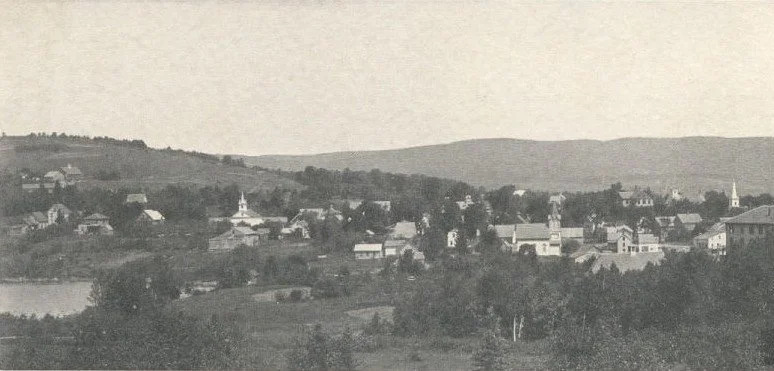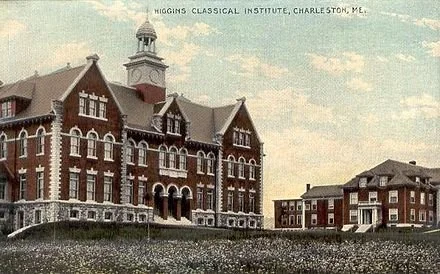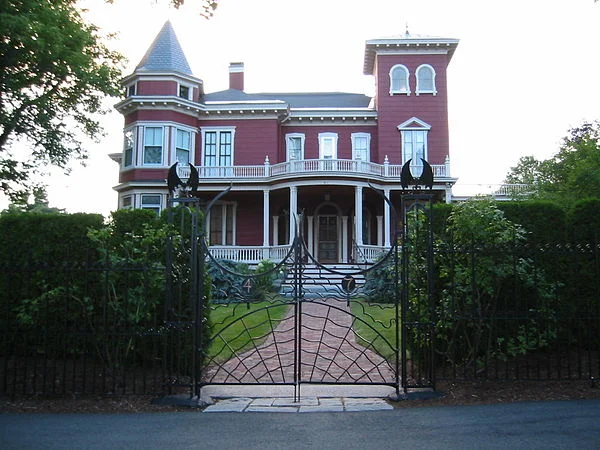
‘Biological narratives’
Untitled work (woodcut and lithograph collage) by Maine-based artist Amanda Lilleston in her show “Deep Field,’’ at The Zillman Art Museum, Bangor, Maine, through Dec. 30.
The museum says:
“Amanda Lilleston explores biological narratives through woodcut printing and collage in her exhibition deep field. The prints highlight the concept of transformation, depicted in burgeoning colors of flora. Lilleston began this body of work about ten years ago – the idea stemming from, ‘a broader, general interconnectedness of systems: biological, physiological, and ecological.’
“The themes that permeate her artwork reflect Lilleston’s educational and life experience – as well as motherhood. The artist explains that she has become ‘acutely aware of my body being part of a larger environment.’ Lilleston thoughtfully examines these natural subjects to allow for adaptation and change within the imagery.”
Turn of the 20th Century postcard. Bangor was for years one of the world’s lumber capitals because of its proximity to the Great North Woods and that Bangor was the last deep water port on the Penobscot River. It also had good freight and passenger rail service.
1918 logo
‘Tolling, gonging, calling’
Monson, Maine, in 1905
“The rolling, winding roads away from Bangor [Maine] took us through towns with names like Charleston, Dover-Foxcroft, Monson, and Shirley, all with their own quaint, beautifully cinematic set dressing. It was like each was curated from grange hall flea markets and movie sets rife with small-town Americana. Stoic stone war memorials. American flags. Whitewashed, chipping town hall buildings from other centuries. Church bell towers in the actual process of tolling, gonging, calling. To me, the sound was ominous in a remote sort of way, unnamable.”
― Katie Lattari, in her thriller novel Dark Things I Adore
In Charleston, Maine: buildings of the former Higgins Classical Institute, a college-preparatory boarding school that existed from 1837 to 1975.
John O. Harney: N.E.’s changing ethnic demographics; shrinking police forces; honorary degrees and culture wars
1. Northwest Vermont 2. Northeast Kingdom 3. Central Vermont 4. Southern Vermont 5. Great North Woods Region 6. White Mountains 7. Lakes Region 8. Dartmouth/Lake Sunapee Region 9. Seacoast Region 10. Merrimack River Valley 11. Monadnock Region 12. North Woods 13. Maine Highlands 14. Acadia/Down East 15. Mid-Coast/Penobscot Bay 16. South Coast 17. Mountain and Lakes Region 18. Kennebec Valley 19. North Shore 20. Metro Boston 21. South Shore 22. Cape Cod and Islands 23. South Coast 24. Southeastern Massachusetts 25. Blackstone River Valley 26. Metrowest/Greater Boston 27. Central Massachusetts 28. Pioneer Valley 29. The Berkshires 30. South Country 31. East Bay and Newport 32. Quiet Corner 33. Greater Hartford 34. Central Naugatuck Valley 35. Northwest Hills 36. Southeastern Connecticut/Greater New London 37. Western Connecticut 38. Connecticut Shoreline
BOSTON
From The New England Journal of Higher Education (NEJHE), a service of The New England Board of Higher Education (nebhe.org)
Population studies. The U.S. Census Bureau released new population counts to use in “redistricting” congressional and state legislative districts. Delayed by the pandemic, the counts came close to the legal deadlines for redistricting in some states, raising concerns about whether there would be enough time for public input.
The U.S. population grew 7.4% in 2010-2020, the slowest growth since the 1930s, according to the bureau. The national growth of about 23 million people occurred entirely of people who identified as Hispanic, Asian, Black or more than one race.
The Associated Press reported:
The population under age 18 dropped from 74.2 million in 2010 to 73.1 million in 2020.
The Asian population increased by one-third over the decade, to stand at 24 million, while the Hispanic population grew by almost a quarter, to top 62 million.
White people made up their smallest-ever share of the U.S. population, dropping from 63.7% in 2010 to 57.8% in 2020. The number of non-Hispanic white people dropped to 191 million in 2020.
The number of people identifying as “two or more races” soared from 9 million in 2010 to 33.8 million in 2020, accounting for about 10% of the U.S. population.
A few New England snippets
Maine remains the nation’s oldest and whitest state, even though it saw a 64% increase in the number of Blacks from 2010 to 2020, as well as large increases in the number of Asians and Pacific Islanders.
Connecticut’s population crawled up 0.9% over the decade from 2010 to 2020 to 3,605,944 residents. The number of residents who are Black, Indigenous and People of Color (BIPOC) increased from 29% of the population in 2010 to 37% in 2020. Connecticut’s number of congressional seats won’t change, but district borders will.
The total population of the only city on Boston’s South Shore, Quincy, Mass., topped 100,000 (at 101,636), as its Asian population grew to represent nearly 31% of all residents. Further south, the city of Brockton’s population increased by nearly 13% as the white population dropped by 29%, and the Black population increased by 26%.
Amazon jungle. Amazon last week announced it will pay full college tuition for its 750,000 U.S. hourly employees, as well as the cost of earning high school diplomas, GEDs, English as a Second Language (ESL) and other certifications. While collecting praise for its educational goodwill, stories of dire conditions in the e-commerce giant’s workplace also triggered a new California law that would ban all warehouses from imposing penalties for “time off-task” (which reportedly discouraged workers from using the bathroom) and prohibit retaliation against workers who complain.
Police shrink. Police forces in New England have recently felt new recruitment and retention pressures. In August 2021, The Providence Journal ran a piece headlined “Promises made, promises delivered? A look at reforms to New England police departments.” GoLocal reported that month that Providence policing staff levels stood at 403, down from 500 or so in the 1980s under then-Mayor David Cicilline. The number of officers employed by Maine’s city and town police departments and county sheriffs’ offices shrank by nearly 6% between 2015 and 2020, according to the Maine Criminal Justice Academy. Reporter Lia Russell of the Bangor Daily News noted, “It’s also a challenge that police in Maine are far from alone in facing, especially following a year during which police practices across the nation were called into question following the murder of George Floyd by Minneapolis police Officer Derek Chauvin.” The Burlington, Vt., City Council in August defeated efforts to reverse a steep cut in city police ranks. The police department currently has 75 sworn officers, down from 90 in June 2020. A survey by the police officers’ union found that roughly half of Burlington cops were actively seeking employment elsewhere.
Honor roll. Honorary degrees are becoming something of a frontline in the culture wars. Springfield College alumnus Donald Brown, who recently coauthored a piece for NEJHE, tells of his alma mater revoking the honorary master of physical education degree it had bestowed on U.S. Olympic Committee Chair Avery Brundage in 1940. In 1968, Brundage pressured the U.S. to take action against two Olympic athletes who gave the Black Power salute after finishing first and second in the 200 meters. That event was only the tip of the iceberg. Brundage had a history of anti-semitism, sexism and racism. Springfield President Mary-Beth Cooper met with the trustees and others and decided to take back the honor. Meanwhile, the University of Rhode Island has been tying itself in knots over the honorary degree it bestowed on Michael Flynn in 2014, before he was appointed Trump’s national security adviser and accused of sedition.
Refugees. After the U.S. ended its longest war (so far) in Afghanistan and the capital of Kabul fell, the question arose of where Afghan refugees would resettle. New England cities, including Worcester, Providence and New Haven, are among those that have readied plans to welcome Afghan refugees. In higher education, Goddard College President Dan Hocoy said it was a “no-brainer” to offer to house Afghan refugees at its Plainfield, Vt., campus for at least two months this upcoming fall. Back in 2004, NEJHE (then Connection) featured an interview with Roger Williams University President Roy J. Nirschel, who died in 2018, and his former wife Paula Nirschel on the university’s role in its community as well as their pioneering initiative to educate Afghan women.
Sunshine state. Before Florida Gov. Ron DeSantis took his most recent stand against fighting COVID, he displayed a narrow-mindedness that seems to always be in fashion. As Inside Higher Ed reported, after expressing concerns about faculty members “indoctrinating” students, DeSantis signed a law requiring that public institutions survey students, faculty and staff members about their viewpoint diversity and sense of intellectual freedom. The Miami Herald reported that DeSantis and state Sen. Ray Rodrigues, the original bill’s Republican sponsor, suggested that the results could inform budget cuts at some institutions. Faculty members have opposed the bill, which also allows students to record their professors teaching in order to file free speech complaints against them.
New colleges in a time of contraction. The nonprofit Norwalk (Conn.) Conservatory of the Arts announced plans to open a new performing-arts college and welcome its first class in August 2022. It’s unusual news amid the stream of college mergers and closures only widened by the pandemic. Among the challenges, many of the faculty members don’t have master of fine arts degrees that accrediting agencies require and, without accreditation, the college’s students won’t be eligible for federal financial aid or Pell Grants.
The Conservatory says the college will consolidate a traditional four-year undergraduate program into two years of intense training and a two-year graduate program into one year. Meanwhile, up the coast, the (Fall River, Mass.) Herald News reports that Denmark-based Maersk Training and Bristol Community College will work together to turn an old seafood packaging plant in New Bedford, Mass., into a National Offshore Wind Institute training facility to train offshore wind workers, complete with classrooms and a deepwater pool to train and recertify workers. (NEJHE has reported on the need to train talent for the burgeoning industry and the coastal economy’s special role in New England.)
Other higher-ed institutions are shapeshifting. After months of discussions and lawsuits, Northeastern University and Mills College reached agreement to establish Mills College at Northeastern University. Founded in 1852, Mills is renowned for its pre-eminence in women’s leadership, access, equity and social justice. Also, billionaire investor Gerald Chan and his family’s Morningside Foundation gave $175 million to the University of Massachusetts Medical School, which will be renamed the University of Massachusetts Chan Medical School. That’s the largest-ever gift to the UMass system.
Land deals. I was recently struck by a report titled We Need to Focus on the Damn Land: Land Grant Universities and Indigenous Nations in the Northeast. The report was born of a partnership between Smith College students and the nonprofit Farm to Institution New England (FINE) to look at how land grant universities view their historic relationships with local Indigenous tribes and how food can play a role in repairing those relationships. It grabbed my attention, partly because NEJHE has published some interesting stories about Native Americans and New England higher education. (See Native Tribal Scholars: Building an Academic Community and A Different Path Forward, both by J. Cedric Woods and The Dark Ages of Education and a New Hope, by Donna Loring.) And partly because two NEBHE Faculty Diversity Fellows, professors Tatiana M.F. Cruz of Simmons University and Kamille Gentles-Peart of Roger Williams University, are spearheading a fascinating Reparative Justice initiative. Among other things, Cruz and Gentles-Peart have had the courage to remind us that land grant universities in New England occupy the land of Indigenous communities. The Smith-FINE work offered sensible recommendations: Financially support Native and Indigenous faculty, activists, programs on campuses and beyond; offer free tuition for Native American students; hire Indigenous people, and fund their research.
John O. Harney is executive editor of The New England Journal of Higher Education.
Good place to scare people from
Stephen King’s rather spooking-looking house in Bangor, Maine, one of many mansions built in the city during Bangor’s 19th Century heyday as a lumber center
“I think one of the reasons that Stephen King’s stories work so well is that he places his stories in spooky old New England, where a lot of American folk legends come from.’’
— Ted Naifeh, American comic-book author and illustrator
Paul Bunyan statue in Bangor
Towering kitsch
The statue of legendary woodsman Paul Bunyan in the old lumber town of Bangor, Maine, is one of those pieces of kitsch that can bring a smile on otherwise depressing days. But sadly, as Lonely Planet noted, "his view of the Penobscot River {which used to be used to float logs down to the coast when Maine was a huge supplier of wood} is now blocked by a casino. ''
Big fortunes were made in the wood business, and Bangor still has many mansions built by those who made these fortunes. One is below, now owned by famous writer Stephen King.












